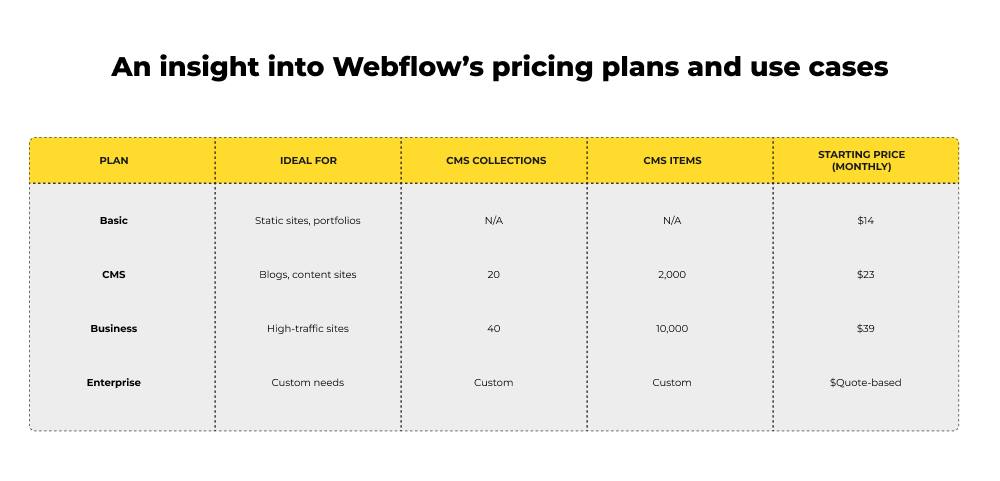So, you are a CMS enthusiast/web dev expert/business owner who has just finished putting together your dream website.
You know exactly how you want it to look, sleek, fast, and unmistakably you. But as soon as you start exploring CMS options, you’re hit with a wave of confusion and a flurry of questions.
“Do I go with WordPress simply because it’s popular?”
“Will Webflow give me enough flexibility without needing a developer?”
“Is Webflow scalable, secure, and future-proof?”
If you’ve found yourself asking these questions, you’re not alone.
For many businesses, choosing the right Content Management System (CMS) feels like picking the foundation of your digital storefront.
It’s not just about aesthetics; it’s also a lot about performance, growth, and how much control you want over your brand’s online story.
At Mavlers, over the past 13+ years, we’ve helped many clients across industries and segments evaluate and migrate between CMS platforms.
One name that frequently comes up in these conversations is Webflow, a platform that promises visual freedom, built-in hosting, and a code-free experience.
However, the seemingly ultimate, ethereal, unanswered question remains: Is Webflow truly the right fit for your business website?
Let’s seek answers to the question and help you decide the perfect-fit CMS for your unique needs, honestly and thoroughly.
Understanding what sets Webflow apart from the other fish in the sea
If you are tired of juggling a multitude of tools, such as a CMS here, a hosting provider there, and a security plugin elsewhere, Webflow comes across as a breath of fresh air and that much-needed respite.
An all-in-one web design, CMS, and hosting platform, Webflow empowers marketers, designers, and developers with the tools to create professional-grade websites without the hassles of code.
Here are some features that set it apart from its contemporaries;
- Visual Design Editor
Creators find much joy and respite in Webflow’s interface, as it is a lively playground. One may think of it as designing in Photoshop, but for the web, where you can drag and drop and customize everything down to the last pixel. Also, behind the scenes, Webflow quietly generates clean, production-ready HTML, CSS, and JavaScript.
2. Built-in CMS
If your site is content-driven, you will benefit from its dynamic content collections, templating, and custom fields. Its built-in CMS makes it a whole lot easier to display and manage content, whether it’s a portfolio, blog, or business site.
3. Integrated hosting & security
With Webflow’s integrated hosting, you get to enjoy fast page loading, SSL certificates, and global content delivery via CDN. Also, with hosting being streamlined, the need for a separate hosting management system and security patches stands eliminated.
4. SEO tools
Webflow provides a range of built-in tools for optimizing your site for search engines, including automatic sitemaps, customizable meta tags, and Open Graph settings.
This means you can easily control your site’s visibility and rankings without relying on third-party plugins.
5. Interactions & animations
You may put to task Webflow’s powerful suite of interactions & animations to render a dynamic experience for your site visitors. Right from features like scroll-triggered animations to micro-interactions, they subtly enhance your site’s engagement factor. On that note, you might want to read ~ Next-Level Animations Just Got Easier in Webflow and We’re Not Kidding!
6. Responsive design
This robust CMS ensures that your website looks flawless across various screen sizes (mobile, tablet, and desktop views), offering flexible breakpoints and design options.
7. Forms & data management
If you need to create simple forms or develop more complex systems that capture user data and automate responses, this platform is equipped with the necessary tools.
8. Collaborative tools
We know that it is seldom that one team member works on a project, and more often, the whole crew pitches in with inputs and edits. Therefore, keeping that in mind, Webflow is quite a natural choice as it supports teams by enabling multiple users to work on the same project simultaneously. Also, real-time editing and version control ensure smooth workflows and minimize chances of errors.

When Webflow is the perfect choice for your web dev project
While Webflow is definitely not a one-size-fits-all solution, it’s a powerful tool when used for the right kind of projects. Let’s explore some cases where it can be a good fit.
- When you crave creative freedom
If your brand is built on originality and you want your website to stand out from everyone else’s, Webflow is your perfect partner.
Its visual editor gives designers full control over layout, spacing, and animations, without relying on rigid templates. Whether you’re building a bold landing page or a sleek corporate portfolio, you can customize every pixel.
Unlike many template-bound CMSs, you’re not boxed in. It’s why creative agencies and design-first startups love Webflow because it lets their imagination translate directly into a functioning website.
2. When you want to avoid maintenance issues
If you ask any WordPress user about plugin updates or theme compatibility nightmares, you’ll get an all-too-familiar knowing sigh.
Interestingly, Webflow eliminates that entire category of stress.
It’s a fully managed platform, meaning you never worry about manual updates, broken plugins, or hosting renewals.
Webflow’s infrastructure automatically handles everything, from backups to security patches.
That makes it ideal for marketing teams and small business owners who don’t have dedicated IT support but still want a professional, fast, secure website.
3. When speed and performance hold importance
Webflow’s hosting stack is built for performance. Sites load quickly, often in under two seconds, because they’re powered by AWS, Fastly CDN, and automatic asset optimization.
So, if you’re running ad campaigns, managing SEO, or simply want users to stick around longer, this kind of built-in speed gives you an edge.
4. When you aspire for a scalable, SEO-optimized site
For brands that rely on organic traffic, Webflow offers practical SEO controls.
You can easily manage on-page optimization without needing Yoast-like plugins.
Plus, its CMS Collections make content scaling (for blogs, case studies, etc.) straightforward and clean.
5. When collaboration is what you need
Designers, marketers, and clients can all work inside Webflow simultaneously. The Editor Mode allows content teams to tweak copy or images without affecting the design structure, thereby reducing the need for back-and-forth communication with developers.
In larger teams, the Enterprise plan introduces granular roles, custom permissions, and advanced version control. It’s perfect for agencies managing multiple client sites or companies with distributed teams.
Decoding the limitations of Webflow
Honestly, there are two sides to every coin, and Webflow is no different. Therefore, it’s better to understand them before committing.
Here’s where you might run into friction.
- Complex data relationships
If your website needs highly relational data, for example, an advanced real estate listing site or a platform that connects multiple content types dynamically, Webflow’s CMS might feel restrictive.
Each CMS Collection supports references and multi-references, but complex relational queries or deeply nested structures (like you’d build with a headless CMS such as Strapi or Sanity) aren’t possible natively.
~ CMS Plan ($23/month): Supports up to 20 collections and 2,000 items.
~ Business Plan ($39/month): Offers 40 collections and 10,000 items.
That’s sufficient for most marketing websites, but probably not ideal for enterprise-scale, data-heavy builds.
2. Offers limited multilingual support
Until recently, creating multilingual sites in Webflow required third-party integrations like Weglot or custom workarounds.
However, Webflow now offers native localization (as of 2024), but it’s still developing.
It supports multiple locales for text and SEO metadata, but dynamic CMS localization and right-to-left language support remain limited.
So if your business operates across several languages or markets, you might still need an external localization tool.
3. Backend customization is quite minimal
Webflow is primarily a front-end-first platform; therefore, you can’t add server-side scripts, manage custom databases, or deploy advanced backend logic.
So, if your business needs complex integrations (CRM workflows, membership portals, advanced API automation), you’ll likely need to connect Webflow with external tools like:
~ Make (Integromat) or Zapier for automations.
~ Memberstack or Outseta for memberships.
~ Airtable or Firebase for extended data management. We also recommend reading ~ The Airtable & Instantly Advantage: How Mavlers Elevated Their Link-Building Game.
These tools work beautifully with Webflow, but it’s an extra layer to plan for.
4. Scaling costs as your business grows
While Webflow’s pricing is transparent, the costs can add up as your needs scale.

While those rates are competitive for managed hosting, costs rise when you need extra team members, CMS items, or localization features.
5. Might not be the right fit for large, content-heavy sites
Webflow enforces a page limit of 150 (Basic) and up to 300 static pages (CMS & Business). CMS-driven content like blog posts doesn’t count toward this limit, but very large sites with hundreds of static pages might find this restrictive.
If your site requires complex taxonomies, deep content hierarchies, or thousands of static pages, Webflow may not be the most scalable solution.
A glimpse into Webflow’s e-commerce features
Webflow’s e-commerce offering is quite a good fit for small to medium sized businesses looking to sell products/services online.
Here are some of it’s key features;
- Product management: One can easily add and manage products, variants, pricing, and inventory with Webflow’s intuitive interface.
2. Checkout & payments: The platform integrates with payment gateways like PayPal and Stripe, offering a customizable checkout experience. Shipping rates, tax rules, and payment gateway integrations are included.
3. Order management: One may track and manage customer orders and payments seamlessly from within the platform.
While it might meet the business requirements of SMBs, larger e-commerce stores or those requiring extensive customization may need to consider alternative solutions.
Is Webflow actually cost-effective? Unveiling the truth
While Webflow isn’t the cheapest CMS out there, its value comes from consolidation.
With Webflow, you don’t need a hosting provider, CDN, plugin licenses, security suite, or a developer for routine updates.
All those come baked in.
So while $23–$39 per month might sound steep compared to basic WordPress hosting, you’re saving time, technical overhead, and long-term maintenance costs.
If you value design freedom and operational ease, it’s worth every penny.
If you want to switch to a WordPress website and ultimately make it more accessible, you might consider reading ~ Drupal vs WordPress: Finding the best CMS for Your Business?
The road ahead
All being said and done, the decision to use Webflow depends on your specific business needs. If you are an enterprise owner looking to try WordPress VIP for your business, you might want to read ~ Unlocking the Power of WordPress VIP: Essential Tips for First-Time Users.


Harshvardhan Sharma - Subject Matter Expert (SME)
With over 9+ years of experience in the dynamic world of HubSpot, Harshvardhan is a seasoned front-end engineer working with Mavlers. Driven by an insatiable curiosity for crafting exceptional digital experiences, he is a passionate advocate for cutting-edge technologies. He thrives on exploring the ever-evolving landscape of front-end development. Beyond the code, he shares knowledge and inspires others through blog posts or open-source contributions.
Pratik Bhatt - Subject Matter Expert (SME)
Pratik Bhatt is a web technology and operations manager focused on delivering front-end solutions that support strategic marketing goals. He specializes in crafting user-centric digital experiences and managing projects with clarity and precision. With strong expertise in CMS platforms and digital asset development, he ensures each initiative is scalable, efficient, and impactful, enhancing user engagement while aligning with broader business objectives.
Naina Sandhir - Content Writer
A content writer at Mavlers, Naina pens quirky, inimitable, and damn relatable content after an in-depth and critical dissection of the topic in question. When not hiking across the Himalayas, she can be found buried in a book with spectacles dangling off her nose!
AI in WordPress: The Ultimate Guide to Building Smarter Websites
How to Conduct Competitive Analysis Using Google Merchant Center Next